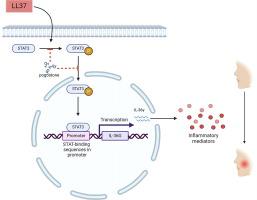当前位置:
X-MOL 学术
›
J. Adv. Res.
›
论文详情
Our official English website, www.x-mol.net, welcomes your feedback! (Note: you will need to create a separate account there.)
Targeting the STAT3/IL-36G signaling pathway can be a promising approach to treat rosacea
Journal of Advanced Research ( IF 11.4 ) Pub Date : 2024-06-22 , DOI: 10.1016/j.jare.2024.06.013 Xin Meng 1 , Yun Zhong 1 , Xuyuan Kuang 2 , Yiya Zhang 3 , Li Yang 3 , Yisheng Cai 3 , Fan Wang 1 , Fanping He 4 , Hongfu Xie 1 , Ben Wang 3 , Ji Li 3
Journal of Advanced Research ( IF 11.4 ) Pub Date : 2024-06-22 , DOI: 10.1016/j.jare.2024.06.013 Xin Meng 1 , Yun Zhong 1 , Xuyuan Kuang 2 , Yiya Zhang 3 , Li Yang 3 , Yisheng Cai 3 , Fan Wang 1 , Fanping He 4 , Hongfu Xie 1 , Ben Wang 3 , Ji Li 3
Affiliation

|
Rosacea is an inflammatory skin disorder characterized by the release of inflammatory mediators from keratinocytes, which are thought to play a crucial role in its pathogenesis. Despite an incidence of approximately 5.5%, rosacea is associated with a poor quality of life. However, as the pathogenesis of rosacea remains enigmatic, treatment options are limited. To investigate the pathogenesis of rosacea and explore new therapeutic strategies. Transcriptome data from rosacea patients combined with immunohistochemical staining were used to investigate the activation of STAT3 in rosacea. The role of STAT3 activation in rosacea was subsequently explored by inhibiting STAT3 activation both in vivo and in vitro. The key molecules downstream of STAT3 activation were identified through data analysis and experiments. Dual-luciferase assay and ChIP-qPCR analysis were used to validate the direct binding of STAT3 to the IL-36G promoter. DARTS, in combination with experimental screening, was employed to identify effective drugs targeting STAT3 for rosacea treatment. STAT3 signaling was hyperactivated in rosacea and served as a promoter of the keratinocyte-driven inflammatory response. Mechanistically, activated STAT3 directly bind to the IL-36G promoter region to amplify downstream inflammatory signals by promoting IL-36G transcription, and treatment with a neutralizing antibody (α-IL36γ) could mitigate rosacea-like inflammation. Notably, a natural plant extract (pogostone), which can interact with STAT3 directly to inhibit its activation and affect the STAT3/IL36G signaling pathway, was screened as a promising topical medication for rosacea treatment. Our study revealed a pivotal role for STAT3/IL36G signaling in the development of rosacea, suggesting that targeting this pathway might be a potential strategy for rosacea treatment.
中文翻译:

靶向 STAT3/IL-36G 信号通路可能是治疗红斑痤疮的一种有前景的方法
红斑痤疮是一种炎症性皮肤病,其特征是角质形成细胞释放炎症介质,这被认为在其发病机制中发挥着至关重要的作用。尽管红斑痤疮的发病率约为 5.5%,但它与生活质量差有关。然而,由于红斑痤疮的发病机制仍然是个谜,治疗选择有限。探讨红斑痤疮的发病机制并探索新的治疗策略。红斑痤疮患者的转录组数据结合免疫组织化学染色用于研究红斑痤疮中 STAT3 的激活。随后通过在体内和体外抑制 STAT3 激活来探索 STAT3 激活在红斑痤疮中的作用。通过数据分析和实验确定了STAT3激活下游的关键分子。使用双荧光素酶测定和 ChIP-qPCR 分析来验证 STAT3 与 IL-36G 启动子的直接结合。 DARTS 与实验筛选相结合,用于识别针对 STAT3 的有效药物,用于治疗红斑痤疮。 STAT3 信号在红斑痤疮中过度激活,并充当角质形成细胞驱动的炎症反应的启动子。从机制上讲,激活的STAT3直接与IL-36G启动子区域结合,通过促进IL-36G转录来放大下游炎症信号,并且用中和抗体(α-IL36γ)治疗可以减轻红斑痤疮样炎症。值得注意的是,一种天然植物提取物(pogostone)可以直接与 STAT3 相互作用,抑制其激活并影响 STAT3/IL36G 信号通路,被筛选为一种有前景的治疗红斑痤疮的外用药物。 我们的研究揭示了 STAT3/IL36G 信号在红斑痤疮发展中的关键作用,表明针对该通路可能是红斑痤疮治疗的潜在策略。
更新日期:2024-06-22
中文翻译:

靶向 STAT3/IL-36G 信号通路可能是治疗红斑痤疮的一种有前景的方法
红斑痤疮是一种炎症性皮肤病,其特征是角质形成细胞释放炎症介质,这被认为在其发病机制中发挥着至关重要的作用。尽管红斑痤疮的发病率约为 5.5%,但它与生活质量差有关。然而,由于红斑痤疮的发病机制仍然是个谜,治疗选择有限。探讨红斑痤疮的发病机制并探索新的治疗策略。红斑痤疮患者的转录组数据结合免疫组织化学染色用于研究红斑痤疮中 STAT3 的激活。随后通过在体内和体外抑制 STAT3 激活来探索 STAT3 激活在红斑痤疮中的作用。通过数据分析和实验确定了STAT3激活下游的关键分子。使用双荧光素酶测定和 ChIP-qPCR 分析来验证 STAT3 与 IL-36G 启动子的直接结合。 DARTS 与实验筛选相结合,用于识别针对 STAT3 的有效药物,用于治疗红斑痤疮。 STAT3 信号在红斑痤疮中过度激活,并充当角质形成细胞驱动的炎症反应的启动子。从机制上讲,激活的STAT3直接与IL-36G启动子区域结合,通过促进IL-36G转录来放大下游炎症信号,并且用中和抗体(α-IL36γ)治疗可以减轻红斑痤疮样炎症。值得注意的是,一种天然植物提取物(pogostone)可以直接与 STAT3 相互作用,抑制其激活并影响 STAT3/IL36G 信号通路,被筛选为一种有前景的治疗红斑痤疮的外用药物。 我们的研究揭示了 STAT3/IL36G 信号在红斑痤疮发展中的关键作用,表明针对该通路可能是红斑痤疮治疗的潜在策略。
















































 京公网安备 11010802027423号
京公网安备 11010802027423号